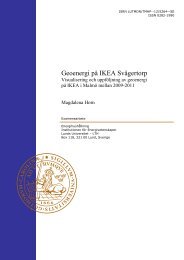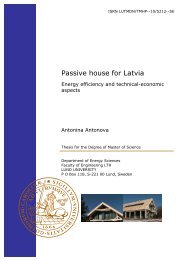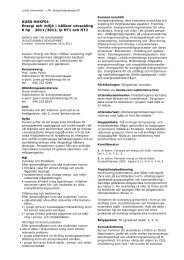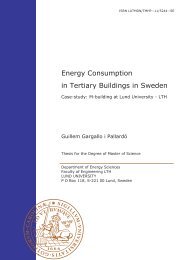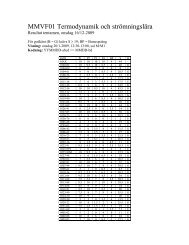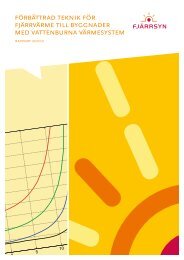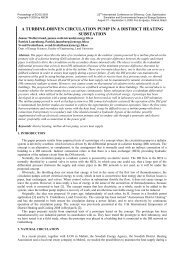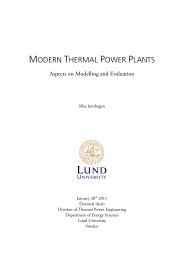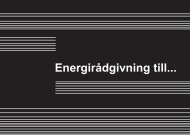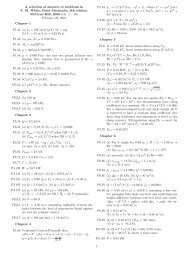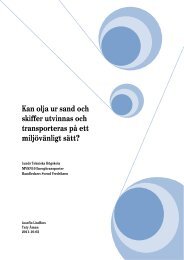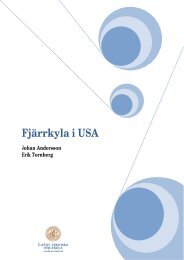What is the pencil-code?
What is the pencil-code?
What is the pencil-code?
Create successful ePaper yourself
Turn your PDF publications into a flip-book with our unique Google optimized e-Paper software.
12D Direct Numerical Simulation ofmethane/air turbulent premixed flames underhigh turbulence intensityJulien Savre04/13/2011Fluid Mechanics seminar series 04/13/2011
2Outline• Why studying turbulent premixed flames under high turbulent intensity?• A free, open-source compressible DNS <strong>code</strong> for combustion applications: The <strong>pencil</strong>-<strong>code</strong>• <strong>What</strong> <strong>is</strong> <strong>the</strong> <strong>pencil</strong>-<strong>code</strong>?• Numerics (brief)• Physical modules• Description of <strong>the</strong> cases and related <strong>is</strong>sues• Results• Computational domain• Initialization• Character<strong>is</strong>ticsFluid Mechanics seminar series 04/13/2011
3Outline• Why studying turbulent premixed flames under high turbulent intensity?• A free, open-source compressible DNS <strong>code</strong> for combustion applications: The <strong>pencil</strong>-<strong>code</strong>• <strong>What</strong> <strong>is</strong> <strong>the</strong> <strong>pencil</strong>-<strong>code</strong>?• Numerics (brief)• Physical modules• Description of <strong>the</strong> cases and related <strong>is</strong>sues• Results• Computational domain• Initialization and homogeneous turbulence• Character<strong>is</strong>ticsFluid Mechanics seminar series 04/13/2011
4Turbulent premixed flames at high Ka• Combustion regimes and diagrams (Poinsot & Veynante, 2001):Ka ≈ 100Karlovitz number:orFluid Mechanics seminar series 04/13/2011
5Turbulent premixed flames at high Ka• Combustion regimes and diagrams (Poinsot & Veynante, 2001):(Kolmogorov scale smaller than<strong>the</strong> inner reaction zone thickness)• Local/global extinction• Combustion instabilities(blow-off)Fluid Mechanics seminar series 04/13/2011
6Turbulent premixed flames at high Ka• There <strong>is</strong> not a good understanding of what happens in that regime• A good example: quenching/reignition phenomena• A clear, comprehensive definition of “quenching phenomena” has yet to be given• Several <strong>the</strong>ories have been proposed and reviewed:– Peters’ <strong>the</strong>ory: <strong>the</strong> smallest turbulent eddies are able to penetrate <strong>the</strong> reaction zone and quench it– Poinsot’s suggestion: those small eddies are too weak and do not survive long enough to effectivelyquench <strong>the</strong> flame (importance of unsteadiness)• Several mechan<strong>is</strong>ms are involved and <strong>the</strong>ir respective contribution <strong>is</strong> still unclear (<strong>the</strong>rmo-diffusiveinstabilities, differential diffusion, heat losses, flame strain, flame wrinkling...)Fluid Mechanics seminar series 04/13/2011
6Turbulent premixed flames at high Ka• There <strong>is</strong> not a good understanding of what happens in that regime• A good example: quenching/reignition phenomena• A clear, comprehensive definition of “quenching phenomena” has yet to be given• Several <strong>the</strong>ories have been proposed and reviewed:– Peters’ <strong>the</strong>ory: <strong>the</strong> smallest turbulent eddies are able to penetrate <strong>the</strong> reaction zone and quench it– Poinsot’s suggestion: those small eddies are too weak and do not survive long enough to effectivelyquench <strong>the</strong> flame (importance of unsteadiness)• Several mechan<strong>is</strong>ms are involved and <strong>the</strong>ir respective contribution <strong>is</strong> still unclear (<strong>the</strong>rmo-diffusiveinstabilities, differential diffusion, heat losses, flame strain, flame wrinkling...)Fluid Mechanics seminar series 04/13/2011
7Turbulent premixed flames at high Ka• Studies of flames in <strong>the</strong> d<strong>is</strong>tributed reaction zone regime and limits:• Few publications:– Experimentally, <strong>the</strong> conditions required to create a flame in that regime are difficult to sustain (stability<strong>is</strong>sues)– Numerically, several obstacles must be overcome (size, memory, accuracy...)• The ex<strong>is</strong>ting investigations rely mainly on laminar flame/vortex interactions (f.i. Poinsot et al., JFM 1991)Fluid Mechanics seminar series 04/13/2011
7Turbulent premixed flames at high Ka• Studies of flames in <strong>the</strong> d<strong>is</strong>tributed reaction zone regime and limits:• Few publications:– Experimentally, <strong>the</strong> conditions required to create a flame in that regime are difficult to sustain (stability<strong>is</strong>sues)– Numerically, several obstacles must be overcome (size, memory, accuracy...)• The ex<strong>is</strong>ting investigations rely mainly on laminar flame/vortex interactions (f.i. Poinsot et al., JFM 1991)Mueller et al.26th Symp., 1996Fluid Mechanics seminar series 04/13/2011
7Turbulent premixed flames at high Ka• Studies of flames in <strong>the</strong> d<strong>is</strong>tributed reaction zone regime and limits:• Few publications:– Experimentally, <strong>the</strong> conditions required to create a flame in that regime are difficult to sustain (stability<strong>is</strong>sues)– Numerically, several obstacles must be overcome (size, memory, accuracy...)• The ex<strong>is</strong>ting investigations rely mainly on laminar flame/vortex interactions (f.i. Poinsot et al., JFM 1991)• Numerical <strong>is</strong>sues:• Finite chem<strong>is</strong>try phenomena require <strong>the</strong> use of relatively detailed kinetic mechan<strong>is</strong>ms• The grid resolution must be very small as <strong>the</strong> small d<strong>is</strong>sipative turbulent scales are smaller than <strong>the</strong>inner reaction layer of <strong>the</strong> flame• The time h<strong>is</strong>tory of flame/turbulence interactions have to be accounted for (importance of transientphenomena)Fluid Mechanics seminar series 04/13/2011
8Objectives• The d<strong>is</strong>tributed reaction zone regime <strong>is</strong> relevant in various practical applications wherequenching/reignition may occur• No turbulent combustion model <strong>is</strong> really efficient to predict those phenomenaAt present, flamelet models are widely used, even underconditions for which <strong>the</strong>y were not designedThere <strong>is</strong> a real need in fur<strong>the</strong>r improving our knowledge of th<strong>is</strong>regime and in developing dedicated modelsFluid Mechanics seminar series 04/13/2011
8Objectives• The d<strong>is</strong>tributed reaction zone regime <strong>is</strong> relevant in various practical applications wherequenching/reignition may occur• No turbulent combustion model <strong>is</strong> really efficient to predict those phenomenaAt present, flamelet models are widely used, even underconditions for which <strong>the</strong>y were not designedThere <strong>is</strong> a real need in fur<strong>the</strong>r improving our knowledge of th<strong>is</strong>regime and in developing dedicated models2D DNS cases are designed here to study methane/air premixed flames in <strong>the</strong> d<strong>is</strong>tributedreaction zone regimeFluid Mechanics seminar series 04/13/2011
9Outline• Why studying turbulent premixed flames under high turbulent intensity?• A free, open-source compressible DNS <strong>code</strong> for combustion applications: The <strong>pencil</strong>-<strong>code</strong>• <strong>What</strong> <strong>is</strong> <strong>the</strong> <strong>pencil</strong>-<strong>code</strong>?• Numerics (brief)• Physical modules• Description of <strong>the</strong> cases and related <strong>is</strong>sues• Results• Computational domain• Initialization• Character<strong>is</strong>ticsFluid Mechanics seminar series 04/13/2011
10<strong>What</strong> <strong>is</strong> <strong>the</strong> <strong>pencil</strong>-<strong>code</strong>?• The <strong>pencil</strong>-<strong>code</strong> <strong>is</strong> a free, open-source, fully-compressible, high-order DNS <strong>code</strong>(available at http://<strong>code</strong>.google.com/p/<strong>pencil</strong>-<strong>code</strong>/)• Developed since 2001, originally for magnetohydrodynamics/astrophysics applications (A.Brandenburg, Stockholm and W. Dobler, Potsdam)• Main character<strong>is</strong>tics:• The <strong>code</strong> <strong>is</strong> accessible via SVN• Systematic reproducibility auto-tests for troubleshooting• The equations are solved along <strong>pencil</strong>s in order to optimize <strong>the</strong> cash memory: all <strong>the</strong> instantaneousphysical quantities are stored in 1D vectors in <strong>the</strong> x direction• The <strong>code</strong> benefits from <strong>the</strong> contribution of several research groups around <strong>the</strong> world: very mature <strong>code</strong>• Written in fortran 90/95• Easy to program and share its developments with <strong>the</strong> community via SVNFluid Mechanics seminar series 04/13/2011
11Numerics• Compressible balance equations (solved under a non-conservative form):• continuity equation• equation of motion (for <strong>the</strong> velocity)• entropy equation (temperature)• species equations• perfect gas law• The equations are solved using a centered sixth-order explicit finite difference scheme (asopposed to compact schemes):• facilitates parallelization (compact schemes require <strong>the</strong> resolution of a tridiagonal system)• to avoid wiggles, upwind schemes are also available for entropy and density equations (5th or 4thorder)Fluid Mechanics seminar series 04/13/2011
12Numerics• Domain, grids and BCs:• Cartesian, cylindrical or spherical referential• Cartesian grids (preferably in a power of 2 for FFTs)• Non regular grids with local stretching (but no adaptive refinement)• Available BCs: periodicity, walls (heated or not), symmetry (no-slip walls), regular inflow/outflow, nonreflectinginflow/outflow (character<strong>is</strong>tic boundary conditions)• Time-stepping:• A 3rd order 2N-Runge Kutta scheme <strong>is</strong> commonly used• Possibility to use an implicit solver for stiff ODEs in combustion applications (LSODE, symmetric fluxsplitting procedure)• The time step can ei<strong>the</strong>r be chosen constant or set by limitations on <strong>the</strong> convective, diffusive or reactionterms:Compressible <strong>code</strong>: CFL based on acoustic wavesFluid Mechanics seminar series 04/13/2011
13Physical modules• Great modularity of <strong>the</strong> <strong>code</strong>: each physical process has its own module• Great transparency as a lot of unnecessary modules remain black boxes (only <strong>the</strong> required modulesare compiled)• Easy to understand and to contribute• Easy to debug• For combustion applications, <strong>the</strong> main required modules are:• NSCBC (non-reflecting boundary conditions)• Entropy (resolution of <strong>the</strong> temperature equation)• Equation of state• Time-step• Chem<strong>is</strong>try (for <strong>the</strong> implementation and validation of chem<strong>is</strong>try in <strong>pencil</strong>, see Babkovskaia et al., JCP2011)Fluid Mechanics seminar series 04/13/2011
14Chem<strong>is</strong>try module• Evaluation of <strong>the</strong> chemical reaction rates as well as <strong>the</strong> transport and <strong>the</strong>rmodynamicproperties:• The CHEMKIN formal<strong>is</strong>m <strong>is</strong> employed• All <strong>the</strong> input files are taken from CHEMKIN (chem.inp, tran.dat)• Th<strong>is</strong> enables <strong>the</strong> use of generic detailed as well as reduced kinetics (ready-to-use CHEMKIN files canbe found on <strong>the</strong> net)• Transport properties: three possibilities available• CHEMKIN format: species diffusion coefficients evaluated as mixture averages of simplified binarydiffusion coefficients (Hirschfelder and Curt<strong>is</strong>s formal<strong>is</strong>m) + flux expressed in terms of molar fractiongradient with <strong>the</strong> possibility to add Dufour and Soret effects• Constant Lew<strong>is</strong> numbers for each species + Fick’s law• Simplified diffusion coefficients (power law of T) + Fick’s lawFluid Mechanics seminar series 04/13/2011
15Outline• Why studying turbulent premixed flames under high turbulent intensity?• A free, open-source compressible DNS <strong>code</strong> for combustion applications: The <strong>pencil</strong>-<strong>code</strong>• <strong>What</strong> <strong>is</strong> <strong>the</strong> <strong>pencil</strong>-<strong>code</strong>?• Numerics (brief)• Physical modules• Description of <strong>the</strong> cases and related <strong>is</strong>sues• Results• Computational domain• Initialization• Character<strong>is</strong>ticsFluid Mechanics seminar series 04/13/2011
16Intro• DNS of premixed flame/turbulence interactions at high Karlovitz number (Ka >> 100)• Short litterature review:• Very limited simulations of flames under such conditions were reported: Poludnenko and Oran (C&F2010), Aspden et al. x2 (33rd Symp., 2011)• Remarks: <strong>the</strong> simulations reported are not DNSs (low-order schemes were used), Aspden et al. areunderresolved, P&O use a 1-step irreversible chem<strong>is</strong>try• Conclusion:Even with huge computational resources, DNSs of flames under high intensity turbulence arestill out of reach unless stringent simplifications are made• Considering <strong>the</strong> ex<strong>is</strong>ting works on <strong>the</strong> topic, we don’t have to be afraid of simplifying <strong>the</strong>simulationsFluid Mechanics seminar series 04/13/2011
17Cases description• Computational domain:• 2D: in <strong>the</strong> flamelet regime, <strong>the</strong> flame <strong>is</strong> most likely to take a cylindrical shape (2D) ra<strong>the</strong>r than aspheroidal one (3D)• 0.6x0.6 cm2• 1024x1024 grid• Dx ≈ 5.9 µm• Boundary conditions:• Periodic in y• non-reflecting inflow/outflow in x• Initialization:• A cold turbulent field <strong>is</strong> first generated using a forcing function in <strong>the</strong> momentum equation:with:• A laminar premixed flame calculated with FlameMaster <strong>is</strong> <strong>the</strong>n overimposed to th<strong>is</strong> initial turbulent fieldFluid Mechanics seminar series 04/13/2011
18Cases description• Physics and Chem<strong>is</strong>try:• We are here interested in methane/air flames• A 16 species, 25 reactions scheme <strong>is</strong> used, suitable for lean premixed flames (Smooke & Giovangigli,1991)• Simplified transport <strong>is</strong> employed (constant Le for each species and heat conductivity expressed as apower of temperature)• For all cases, <strong>the</strong> turbulence decays over a time equivalent to 1 eddy turnover-timeCases L (cm) u’ (cm/s) eta (µm) Re KaCase 1 0.209 5900 2.7 7700 7000Case 2 0.209 940 8 1250 820Case 3 0.126 4850 2.7 3820 7000Fluid Mechanics seminar series 04/13/2011
19Outline• Why studying turbulent premixed flames under high turbulent intensity?• A free, open-source compressible DNS <strong>code</strong> for combustion applications: The <strong>pencil</strong>-<strong>code</strong>• <strong>What</strong> <strong>is</strong> <strong>the</strong> <strong>pencil</strong>-<strong>code</strong>?• Numerics (brief)• Physical modules• Description of <strong>the</strong> cases and related <strong>is</strong>sues• Results• Computational domain• Initialization• Character<strong>is</strong>ticsFluid Mechanics seminar series 04/13/2011
202D decaying homogeneous turbulence• Properties of decaying turbulence are crucial in those simulations. We have to be carefullthat:• The simulation <strong>is</strong> sufficiently well resolved (in our case, <strong>the</strong> flame front being much larger than <strong>the</strong>Kolmogorov scale, <strong>the</strong> resolution criterion <strong>is</strong> imposed by turbulence and not by <strong>the</strong> flame)• Turbulence does not decay too much• Decay of TKE in power of t after a short transient period:After some manipulations:Fluid Mechanics seminar series 04/13/2011
202D decaying homogeneous turbulence• Properties of decaying turbulence are crucial in those simulations. We have to be carefullthat:• The simulation <strong>is</strong> sufficiently well resolved (in our case, <strong>the</strong> flame front being much larger than <strong>the</strong>Kolmogorov scale, <strong>the</strong> resolution criterion <strong>is</strong> imposed by turbulence and not by <strong>the</strong> flame)• Turbulence does not decay too much• Decay of TKE in power of t after a short transient period:After some manipulations:Ex<strong>is</strong>tence of a threshold at high Re (m=-1) over which v<strong>is</strong>cous effects decrease during <strong>the</strong>decay : physically incons<strong>is</strong>tent but hard to avoidFluid Mechanics seminar series 04/13/2011
212D decaying homogeneous turbulenceL=0.209, 1024L=0.209, 2048L=0.209, 51210000L=0.209, 1024L=0.209, 2048L=0.126, Ka=7000L=0.209, Ka=820kKa10001x10 7n = -0.162n = -0.169n = -0.131001x10 -7 1x10 -6 0.00001Ka=7000, 1024Ka=7000, 2048Ka=820, 1024Ka=7000, L=0.126t0.01 0.1 1t/tauTo characterize <strong>the</strong> overall resolution:nu_e0.1 1Fluid Mechanics seminar series t/tau04/13/2011
212D decaying homogeneous turbulenceL=0.209, 1024L=0.209, 2048L=0.209, 51210000L=0.209, 1024L=0.209, 2048L=0.126, Ka=7000L=0.209, Ka=820kKa10001x10 7n = -0.162n = -0.169n = -0.131001x10 -7 1x10 -6 0.00001Ka=7000, 1024Ka=7000, 2048Ka=820, 1024Ka=7000, L=0.126t0.01 0.1 1t/tauTo characterize <strong>the</strong> overall resolution:nu_eNumerical d<strong>is</strong>sipation0.1 1Fluid Mechanics seminar series t/tau04/13/2011
22Instantaneous snapshotsL=0.209, Ka=820• Progress variable contours:L=0.126, Ka=7000• Reaction zone: 0.75 < c < 0.95L=0.209, Ka=7000• Vorticity <strong>is</strong>o-linesFluid Mechanics seminar series 04/13/2011
23Instantaneous snapshots• Heat release contours and vorticity linesL=0.209, Ka=7000L=0.209, Ka=820Fluid Mechanics seminar series 04/13/2011
23Instantaneous snapshots• Heat release contours and vorticity linesL=0.209, Ka=7000L=0.209, Ka=820Presence of small vortices within<strong>the</strong> reaction zone at Ka=7000Fluid Mechanics seminar series 04/13/2011
23Instantaneous snapshots• Heat release contours and vorticity linesL=0.209, Ka=7000L=0.209, Ka=820Presence of small vortices within<strong>the</strong> reaction zone at Ka=7000Ex<strong>is</strong>tence of low HR regions:local quenching in progressFluid Mechanics seminar series 04/13/2011
24Curvature correlations• Correlations between local curvature and heat release rate at c=0.8 (inside <strong>the</strong> reaction zone)• Positive correlation at Ka=820, 0 correlation at Ka=7000• In both cases: low heat release rate regions correspond to negatively curved elements(importance of curvature effects)Fluid Mechanics seminar series 04/13/2011
25Remarks• In cases 1 and 3, at Ka=7000, <strong>the</strong> flames belong to <strong>the</strong> d<strong>is</strong>tributed flame regime:• Presence of small vortices inside <strong>the</strong> fuel consumption layer• The reaction layer <strong>is</strong> quite irregular exhibiting locally stretched elements• In case 2, at Ka=820, <strong>the</strong> flame seems not to belong to <strong>the</strong> d<strong>is</strong>tributed flame regime:• No vortices are able to penetrate <strong>the</strong> reaction zone• The reaction layer <strong>is</strong> very regular, with a constant thickness• In all cases:• The inner reaction layer <strong>is</strong> locally quenched, showing reduced HR rate• Two important conclusions:• The fuel consumption layer can be quenched even if small scale vortices cannot survive within it• The d<strong>is</strong>tributed flame regime <strong>is</strong> reached for Karlovitz numbers much higher than 100Fluid Mechanics seminar series 04/13/2011
26Remarks• The limit Ka=100 <strong>is</strong> largely exceeded mainly because <strong>the</strong> definition of Ka doesn’t account for<strong>the</strong>rmal expansion as temperature increases• Previous studies of laminar flame/vortex interactions have shown that <strong>the</strong> vortex surface in<strong>the</strong> burnt gases <strong>is</strong> multiplied by• The vortex rotation velocity <strong>is</strong> divided by <strong>the</strong> same factorFluid Mechanics seminar series 04/13/2011
26Remarks• The limit Ka=100 <strong>is</strong> largely exceeded mainly because <strong>the</strong> definition of Ka doesn’t account for<strong>the</strong>rmal expansion as temperature increases• Previous studies of laminar flame/vortex interactions have shown that <strong>the</strong> vortex surface in<strong>the</strong> burnt gases <strong>is</strong> multiplied by• The vortex rotation velocity <strong>is</strong> divided by <strong>the</strong> same factor• Redifining <strong>the</strong> Karlovitz number according to gas expansion:• Methane/air at Φ=0.7: τ=6.2Fluid Mechanics seminar series 04/13/2011
27Remarks• Corrected Ka estimates:Cases L (cm) Ka Ka*Cases 1 - 2 0.209 - 0.126 7000 450Case 3 0.209 820 50• Ka* <strong>is</strong> still a rough estimate but <strong>is</strong> coherent with <strong>the</strong> observationsAccording to th<strong>is</strong> new definition, Case 3 no longer belongs to <strong>the</strong> d<strong>is</strong>tributed flame regime, assuggested by <strong>the</strong> snapshotsFluid Mechanics seminar series 04/13/2011
27Remarks• Corrected Ka estimates:Cases L (cm) Ka Ka*Cases 1 - 2 0.209 - 0.126 7000 450Case 3 0.209 820 50• Ka* <strong>is</strong> still a rough estimate but <strong>is</strong> coherent with <strong>the</strong> observationsAccording to th<strong>is</strong> new definition, Case 3 no longer belongs to <strong>the</strong> d<strong>is</strong>tributed flame regime, assuggested by <strong>the</strong> snapshots• In <strong>the</strong> following, ano<strong>the</strong>r definition of <strong>the</strong> progress variable will be employed:• Allows a detailed description of <strong>the</strong> entire flame front (including <strong>the</strong> oxidation layer)Fluid Mechanics seminar series 04/13/2011
28Turbulent flame structure (case 2)• Scatter plots of temperature and species mass fractions accross <strong>the</strong> flame with respect to <strong>the</strong>progress variable:• Quasi linear response of T and major species mass fractions:cons<strong>is</strong>tent with <strong>the</strong> results of Aspden et al. (PCI 2011) with various fuelsFluid Mechanics seminar series 04/13/2011
29Turbulent flame structure (case 2)• Radical peaks (here H) are dramatically increased in <strong>the</strong> turbulent flame: chain branchingreactions become dominant to <strong>the</strong> expense of chain terminating reactions• Direct effect of turbulent mixing within <strong>the</strong> flame front• Increased CO peak and equilibrium level: cons<strong>is</strong>tent with turbulent flame experimentsFluid Mechanics seminar series 04/13/2011
30Turbulent flame structure (case 2)• CH2O becomes significant early in <strong>the</strong> preheat zone suggesting flame broadening (in agreementwith recent experimental observations)• Unlike o<strong>the</strong>r radicals, CH3 formation <strong>is</strong> mainly decreased accross <strong>the</strong> flameFluid Mechanics seminar series 04/13/2011
30Turbulent flame structure (case 2)Overestimated levels ofCH3 in <strong>the</strong> preheat zone:effects of reducedchem<strong>is</strong>try• CH2O becomes significant early in <strong>the</strong> preheat zone suggesting flame broadening (in agreementwith recent experimental observations)• Unlike o<strong>the</strong>r radicals, CH3 formation <strong>is</strong> mainly decreased accross <strong>the</strong> flameFluid Mechanics seminar series 04/13/2011
31Conclusion• Summary:• 2D DNS of lean premixed turbulent methane/air flames at Ka > 100 were achieved• Use of <strong>the</strong> <strong>pencil</strong>-<strong>code</strong> (evaluation of <strong>the</strong> <strong>code</strong> for complexe reactive flows) with reduced chem<strong>is</strong>tryand simplified transport• Investigation of turbulent flame structure and response of <strong>the</strong> inner reaction zone• Conclusions:• The <strong>pencil</strong>-<strong>code</strong> <strong>is</strong> perfectly adapted to <strong>the</strong> kind of simulations proposed here, and performed betterthan expected in terms of CPU time: simulation time of 120 h (for case 2)Case Nproc Phys. time N steps mean Δt CPU/Δt/pts total CPU2 32 217 µs 92600 2.3 ns 4.45 µs 3840 hFluid Mechanics seminar series 04/13/2011
32Conclusion• Conclusions:• Local quenching was observed along <strong>the</strong> inner reaction layer, but no global extinction (that seems farmore difficult to achieve as <strong>the</strong> burnt gases constantly provide heat)• The d<strong>is</strong>tributed flame regime <strong>is</strong> reached for higher Ka than expected: accounting for flow dilataion in<strong>the</strong> definition of Ka seems to provide a better evaluation of th<strong>is</strong> limit• The inner flame structure and species d<strong>is</strong>tributions seem cons<strong>is</strong>tent with experimental observationsand numerical simulations:» Quasi linear response of temperature with respect to <strong>the</strong> fuel mass fraction» Broadening of <strong>the</strong> formaldehyde layer» Increased CO levels• The chemical paths at such high turbulence intensities are highly perturbed:» Chain branching reactions are more dominant» The formation of formaldehyde via CH3 seems pivotal during <strong>the</strong> quenching process whichra<strong>is</strong>es one crucial <strong>is</strong>sue:Fluid Mechanics seminar series 04/13/2011
32Conclusion• Conclusions:• Local quenching was observed along <strong>the</strong> inner reaction layer, but no global extinction (that seems farmore difficult to achieve as <strong>the</strong> burnt gases constantly provide heat)• The d<strong>is</strong>tributed flame regime <strong>is</strong> reached for higher Ka than expected: accounting for flow dilataion in<strong>the</strong> definition of Ka seems to provide a better evaluation of th<strong>is</strong> limit• The inner flame structure and species d<strong>is</strong>tributions seem cons<strong>is</strong>tent with experimental observationsand numerical simulations:» Quasi linear response of temperature with respect to <strong>the</strong> fuel mass fraction» Broadening of <strong>the</strong> formaldehyde layer» Increased CO levels• The chemical paths at such high turbulence intensities are highly perturbed:» Chain branching reactions are more dominant» The formation of formaldehyde via CH3 seems pivotal during <strong>the</strong> quenching process whichra<strong>is</strong>es one crucial <strong>is</strong>sue:Is it appropriate to use a reduced kinetic mechan<strong>is</strong>m to predict small scale turbulence/flameinteractions; & how accurate must be <strong>the</strong> CH3 reaction path?Fluid Mechanics seminar series 04/13/2011
33Conclusion• Future works:• At least two more simulations could bring additional informations:» Ka=2000 (or Ka*=150): limit of <strong>the</strong> d<strong>is</strong>tributed flame regime in terms of Ka*» Ka=150: limit of <strong>the</strong> d<strong>is</strong>tributed flame regime in terms of Ka• Detailed investigation of transport processes within <strong>the</strong> flame front: turbulent transport vs. differentialdiffusion (in progress)• Study of time h<strong>is</strong>tory of <strong>the</strong> quenching process: how <strong>the</strong> holes will evolve?• Given <strong>the</strong> available computational resources, it seems still difficult to increase <strong>the</strong> accuracyof <strong>the</strong> simulations (3D, better resolution, more detailed chem<strong>is</strong>try...)Fluid Mechanics seminar series 04/13/2011
34Overview of <strong>the</strong> chemical structure• Carbon chain:• Importance of reaction R13:• Contribution of 2 reactions to <strong>the</strong> consumption of CH3: compar<strong>is</strong>onbetween a positively curved region and a “hole”Fluid Mechanics seminar series 04/13/2011
34Overview of <strong>the</strong> chemical structure• Carbon chain:• Importance of reaction R13:• Contribution of 2 reactions to <strong>the</strong> consumption of CH3: compar<strong>is</strong>onbetween a positively curved region and a “hole”Clear change in <strong>the</strong> chemical path:R11 becomes dominant to <strong>the</strong>expense of R13Fluid Mechanics seminar series 04/13/2011
34Overview of <strong>the</strong> chemical structure• Carbon chain:• Importance of reaction R13:• Contribution of 2 reactions to <strong>the</strong> consumption of CH3: compar<strong>is</strong>onbetween a positively curved region and a “hole”Clear change in <strong>the</strong> chemical path:R11 becomes dominant to <strong>the</strong>expense of R13The carbon chain <strong>is</strong> broken by a default offormaldehyde productionFluid Mechanics seminar series 04/13/2011



